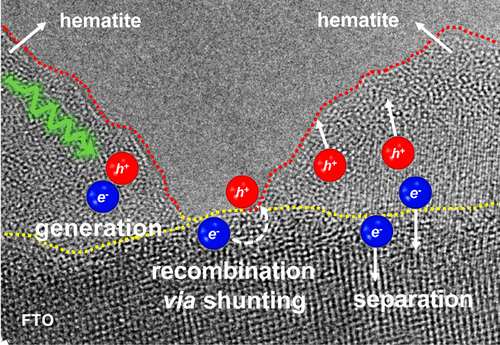当前位置:
X-MOL 学术
›
ACS Energy Lett.
›
论文详情
Our official English website, www.x-mol.net, welcomes your
feedback! (Note: you will need to create a separate account there.)
Catalyst Deposition on Photoanodes: The Roles of Intrinsic Catalytic Activity, Catalyst Electrical Conductivity, and Semiconductor Morphology
ACS Energy Letters ( IF 19.3 ) Pub Date : 2018-03-20 00:00:00 , DOI: 10.1021/acsenergylett.8b00336 Jingjing Qiu 1 , Hamed Hajibabaei 2 , Michael R. Nellist 1 , Forrest A. L. Laskowski 1 , Sebastian Z. Oener 1 , Thomas W. Hamann 2 , Shannon W. Boettcher 1
ACS Energy Letters ( IF 19.3 ) Pub Date : 2018-03-20 00:00:00 , DOI: 10.1021/acsenergylett.8b00336 Jingjing Qiu 1 , Hamed Hajibabaei 2 , Michael R. Nellist 1 , Forrest A. L. Laskowski 1 , Sebastian Z. Oener 1 , Thomas W. Hamann 2 , Shannon W. Boettcher 1
Affiliation

|
Semiconducting oxide photoanodes are used to drive the oxygen evolution reaction (OER) in water-splitting systems. The highest-performing systems use nanostructured semiconductors coated with water-oxidation catalysts. Despite much work, the design principles governing the integration of catalysts with semiconductors are poorly understood. Using hematite as a model system, we show how semiconductor morphology and electrical conductivity of the catalyst affect the system photoresponse. Electrically conductive catalysts can introduce substantial “shunt” recombination currents if they contact both the semiconductor surface and the underlying conducting-glass substrate, leading to poor performance. This recombination can be largely eliminated by using pinhole-free semiconductors, using selective photoassisted electrodeposition of thin catalyst layers on the semiconductor surface, using electrically insulating catalyst layers, or adding an intermediate insulating oxide layer. The results of this study are used to clarify the mechanisms behind several important results reported in the literature.
中文翻译:

光阳极上的催化剂沉积:内在催化活性,催化剂电导率和半导体形态的作用
半导体氧化物光阳极用于驱动水分解系统中的氧释放反应(OER)。最高性能的系统使用涂有水氧化催化剂的纳米结构半导体。尽管做了很多工作,但对催化剂与半导体集成的设计原理知之甚少。使用赤铁矿作为模型系统,我们展示了催化剂的半导体形态和电导率如何影响系统的光响应。如果导电催化剂同时接触半导体表面和下面的导电玻璃基板,则它们可能会引入大量的“分流”复合电流,从而导致性能不佳。通过使用无针孔的半导体,可以大大消除这种复合,使用选择性光辅助电沉积在半导体表面上的薄催化剂层,使用电绝缘催化剂层或添加中间绝缘氧化物层。这项研究的结果用于阐明文献中报道的几个重要结果背后的机制。
更新日期:2018-03-20
中文翻译:

光阳极上的催化剂沉积:内在催化活性,催化剂电导率和半导体形态的作用
半导体氧化物光阳极用于驱动水分解系统中的氧释放反应(OER)。最高性能的系统使用涂有水氧化催化剂的纳米结构半导体。尽管做了很多工作,但对催化剂与半导体集成的设计原理知之甚少。使用赤铁矿作为模型系统,我们展示了催化剂的半导体形态和电导率如何影响系统的光响应。如果导电催化剂同时接触半导体表面和下面的导电玻璃基板,则它们可能会引入大量的“分流”复合电流,从而导致性能不佳。通过使用无针孔的半导体,可以大大消除这种复合,使用选择性光辅助电沉积在半导体表面上的薄催化剂层,使用电绝缘催化剂层或添加中间绝缘氧化物层。这项研究的结果用于阐明文献中报道的几个重要结果背后的机制。











































 京公网安备 11010802027423号
京公网安备 11010802027423号